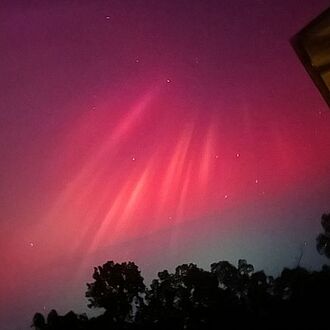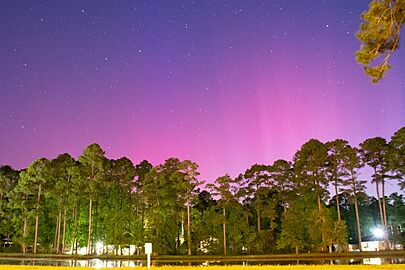May 2024 solar storms facts for kids

|
|
| Date | May 2024 |
|---|---|
| Type | Coronal mass ejection |
| Part of Solar cycle 25 | |
The solar storms of May 2024 were a powerful series of events from the Sun that caused amazing light shows on Earth. These storms included strong solar flares and geomagnetic storms, starting around May 10, 2024. They happened during solar cycle 25, which is a period of increased solar activity.
One of the most exciting results of these storms was seeing aurorae (also known as the Northern and Southern Lights) in places much closer to the equator than usual.
Contents
Solar Flares and CMEs
Solar flares are huge bursts of energy and light from the Sun's surface. Sometimes, these flares are followed by a coronal mass ejection (CME). A CME is a giant cloud of super-hot gas and magnetic fields that shoots out from the Sun.
On May 8, 2024, a very active spot on the Sun, called NOAA region 3664, started producing many strong solar flares. Some of these were "X-class" flares, which are the most powerful kind. This active region also launched several CMEs directly towards Earth.
Over the next few days, this busy spot on the Sun kept firing off more X-class flares and CMEs. One of the biggest flares was an X5.89 flare on May 11. These CMEs were like giant magnetic bubbles heading our way.
Geomagnetic Storms and Auroras
When CMEs reach Earth, they can hit our planet's magnetic field. This causes a geomagnetic storm. The CMEs from May 8 arrived on May 10, making a severe to extreme geomagnetic storm. This storm created incredibly bright and long-lasting auroras.
People saw these beautiful lights in many unexpected places. In Europe, auroras were visible right after sunset, even in countries like Croatia. In America, the lights were seen as far south as Florida. In the Southern Hemisphere, auroras lit up the skies in New Zealand, Australia, Chile, and Argentina.
The strength of the storm was measured by how much it affected Earth's magnetic field. It was so strong that it was rated a G5 storm. This made it the most intense solar storm since the 2003 Halloween solar storms. More CMEs were expected to arrive on May 11 and 12, keeping the activity going.
How This Storm Compares
Scientists use something called the disturbance storm time index (Dst) to measure how much Earth's magnetic field is affected by solar storms. A very low (negative) Dst value means the magnetic field is weakened a lot.
For example, the May 1921 geomagnetic storm had a Dst value of about -907 nT. The famous Carrington Event of 1859, which was a superstorm, had Dst estimates between -800 nT and -1750 nT.
The May 2024 solar storms reached a Dst value of -412 nT. While this is very strong and caused amazing auroras, it was not as powerful as some of the biggest storms in history like the Carrington Event.
Gallery
Aurorae
-
Aurora as seen from Osage Beach, Missouri
-
Aurora as seen from Pawleys Island, South Carolina
-
Aurora as seen from East Sussex, UK
-
Aurora as seen from Okeford Hill, Dorset, UK
-
Aurora as seen from Bay View, Washington
-
Aurora as seen from Kraków, Poland
See also
 In Spanish: Tormentas solares de mayo de 2024 para niños
In Spanish: Tormentas solares de mayo de 2024 para niños
- List of solar storms








